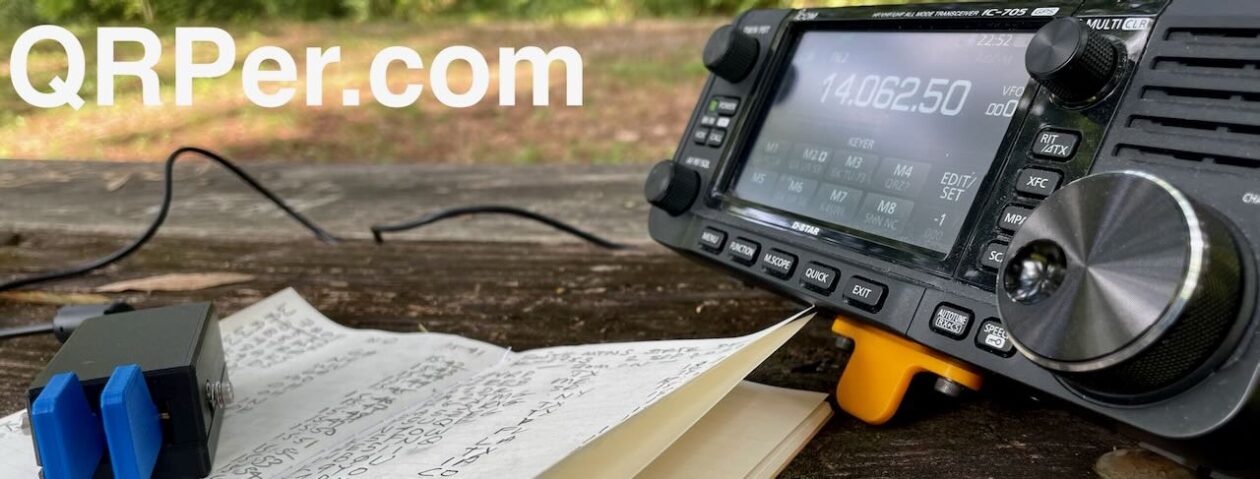by Thomas (K4SWL)
If you’ve been a QRPer.com reader or subscriber to my YouTube channel for long, you’ll know I’m quite the fan of super-compact, low-profile antennas like the Elecraft AX1 and AX2.
In fact, I just checked, and my Elecraft AX1 activation video playlist alone includes 36 videos as of this post.
Although AX antennas are certainly a compromise in terms of performance, I find them surprisingly effective for on-the-air programs like SOTA, POTA, and WWFF. While they’re not high-gain, they’re also far from the “dummy load” some make them out to be. In fact, the best DX I’ve ever worked in the field was with my Elecraft AX2 and just 5 watts of power—check out the field report.
The New AX3
 A couple of weeks ago, Wayne Burdick of Elecraft announced the new Elecraft AX3 portable antenna, the latest addition to the AX line.
A couple of weeks ago, Wayne Burdick of Elecraft announced the new Elecraft AX3 portable antenna, the latest addition to the AX line.
Unlike the AX1 and AX2—which attach directly to the radio—the AX3 is fully self-supporting, thanks to its detachable tripod legs and 1/4-20 base mount. This adds next-level mounting versatility, making it ideal for tabletop or ground deployment. (Check out how Conrad so easily mounted it to two different tripod options in his recent field report.)
It covers 30 through 10 meters and uses a 4-position band selector plug, which I personally find more rugged than the AX1’s band switch. Like its siblings, the AX3 is designed to pair with an ATU, but unlike the AX1/AX2, it doesn’t need to physically mount to the transceiver—so it’s compatible with virtually any rig and tuner combo. The AX3 also supports up to 30 watts.
 Despite the added versatility, the AX3 still packs incredibly small: the whip, base, and tripod legs collapse to just 6 inches, yet the whip extends to 45 inches in the field. The side-mounted BNC connector avoids awkward cable bends or adapters.
Despite the added versatility, the AX3 still packs incredibly small: the whip, base, and tripod legs collapse to just 6 inches, yet the whip extends to 45 inches in the field. The side-mounted BNC connector avoids awkward cable bends or adapters.
In the spirit of full disclosure, I’m in the testing group for the Elecraft KH1 and, as such, I was aware the new AX3 was on the horizon, but I had not yet tested it in the field until I ordered one and it was delivered on Tuesday, April 29, 2025.
From Unboxing to Activation
 Since Hurricane Helene wiped out our local post office, my buddy Vlado (N3CZ) has kindly allowed me to have parcels delivered to his house. When he told me that “a small box” had arrived from Elecraft, I knew exactly what it was.
Since Hurricane Helene wiped out our local post office, my buddy Vlado (N3CZ) has kindly allowed me to have parcels delivered to his house. When he told me that “a small box” had arrived from Elecraft, I knew exactly what it was.
I had an errand in town that afternoon, so I swung by Vlado’s, picked up the package, and then stopped at the Blue Ridge Parkway Folk Art Center to perform the AX3’s debut activation.
 Of course, I packed my Elecraft KX2, thinking it would only be right to pair the AX3 with an Elecraft radio for its first outing!
Of course, I packed my Elecraft KX2, thinking it would only be right to pair the AX3 with an Elecraft radio for its first outing!
In my activation video (below), you’ll see that assembling the AX3 was incredibly simple right out of the box. I ordered the full AX3 package, which includes the antenna, mini banana plug, counterpoise wire, tripod legs, BNC-to-BNC cable assembly, and a small nylon storage bag.
 I attached the tripod legs, screwed on the whip antenna, clipped the counterpoise to the ground lug, and connected the BNC cable. In less than a minute, the antenna was fully deployed and ready to go!
I attached the tripod legs, screwed on the whip antenna, clipped the counterpoise to the ground lug, and connected the BNC cable. In less than a minute, the antenna was fully deployed and ready to go!
Gear
 Note: All Amazon, CW Morse, ABR, Chelegance, Spooltenna, eBay, and Radioddity links are affiliate links that support QRPer.com at no cost to you.
Note: All Amazon, CW Morse, ABR, Chelegance, Spooltenna, eBay, and Radioddity links are affiliate links that support QRPer.com at no cost to you.
Radio
- Elecraft KX2 transceiver
- Tufteln KX2 Protective CoverElecraft KX2 with Windcamp X2 Side Rails
- Elecraft KXBT2 Li-Ion Battery Pack
Key
- BaMaKeY TP-III Ultra-Compact Twin Paddle
- Key cable: Cable Matters 2-Pack Gold-Plated Retractable Aux Cable – 2.5 Feet
Antenna
- Elecraft AX3 package
Battery
Pack/Case
Log and Pen
Camera/Audio Gear
- DJI OSMO 4 action camera with Joby Telepod Sport Tripod
- DJI Wireless Microphones
On The Air
 The first thing I did was make sure the band plug was set to 14 MHz, then pressed the ATU button to find a match on 20 meters. Continue reading From Box to POTA: First Activation with the New Elecraft AX3!
The first thing I did was make sure the band plug was set to 14 MHz, then pressed the ATU button to find a match on 20 meters. Continue reading From Box to POTA: First Activation with the New Elecraft AX3!



















 This will be corrected tomorrow.
This will be corrected tomorrow.